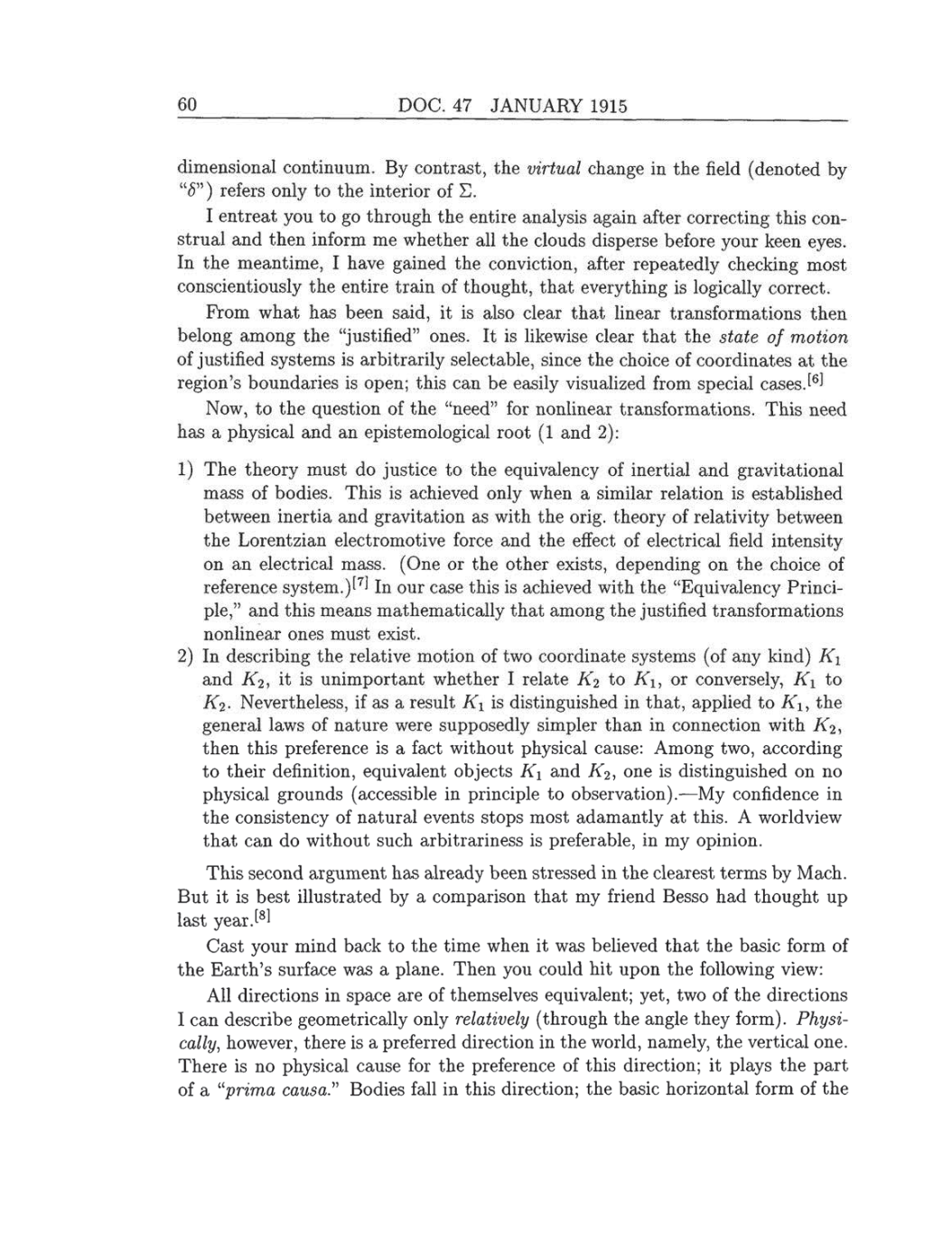60 DOC.
47 JANUARY
1915
dimensional continuum.
By
contrast,
the
virtual
change
in
the
field
(denoted by
“S”)
refers
only
to
the
interior of E.
I
entreat
you
to
go
through
the
entire
analysis again
after
correcting
this
con-
strual
and
then
inform
me
whether all
the
clouds
disperse
before
your
keen
eyes.
In
the
meantime,
I
have
gained
the
conviction,
after
repeatedly
checking
most
conscientiously
the
entire
train
of
thought,
that
everything
is
logically
correct.
From
what
has been
said,
it
is also clear
that
linear
transformations then
belong among
the
“justified”
ones.
It
is
likewise clear
that the
state
of
motion
of
justified systems
is arbitrarily
selectable,
since
the
choice of
coordinates
at
the
region’s
boundaries
is
open;
this
can
be
easily
visualized from
special
cases.[6]
Now,
to
the
question
of
the
“need”
for nonlinear
transformations. This
need
has
a physical
and
an epistemological
root
(1
and
2):
1)
The
theory must
do
justice
to
the
equivalency
of
inertial and
gravitational
mass
of bodies. This
is
achieved
only
when
a
similar
relation
is established
between
inertia
and
gravitation
as
with
the
orig. theory
of
relativity
between
the
Lorentzian electromotive force and
the
effect
of electrical
field intensity
on an
electrical
mass. (One or
the other
exists, depending
on
the
choice of
reference
system.)[7]
In
our case
this
is
achieved with
the
“Equivalency
Princi-
ple,”
and
this
means
mathematically
that
among
the
justified
transformations
nonlinear
ones
must exist.
2)
In
describing
the
relative motion of two coordinate
systems (of any kind) K1
and
K2,
it
is unimportant
whether
I
relate
K2
to
K1, or
conversely,
K1
to
K2. Nevertheless,
if
as a
result
K1
is
distinguished
in that,
applied
to
K1,
the
general
laws of
nature
were
supposedly simpler
than
in connection with
K2,
then
this
preference
is
a
fact
without
physical
cause:
Among two, according
to
their
definition, equivalent objects
K1
and
K2, one
is
distinguished
on no
physical grounds (accessible
in
principle
to
observation).-My
confidence in
the
consistency
of
natural
events
stops
most
adamantly
at this.
A
worldview
that
can
do
without
such
arbitrariness
is
preferable,
in
my opinion.
This
second
argument
has
already
been stressed in
the
clearest
terms
by
Mach.
But
it
is
best illustrated
by
a
comparison
that
my
friend Besso
had
thought
up
last
year.[8]
Cast
your
mind back to
the
time when it
was
believed
that the
basic form of
the Earth’s
surface
was a plane.
Then
you
could
hit
upon
the
following
view:
All directions in
space
are
of themselves
equivalent; yet,
two
of
the
directions
I
can
describe
geometrically
only relatively (through
the
angle
they
form).
Physi-
cally,
however,
there
is
a
preferred
direction in
the
world, namely,
the
vertical
one.
There
is
no
physical
cause
for
the
preference
of this
direction;
it
plays
the
part
of
a
"prima
causa." Bodies fall
in
this
direction;
the
basic horizontal form of
the
